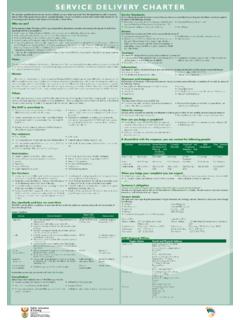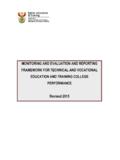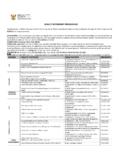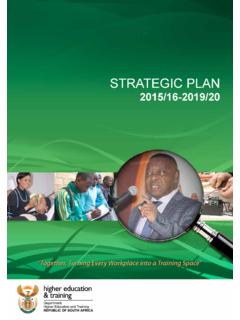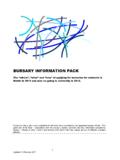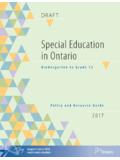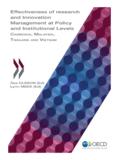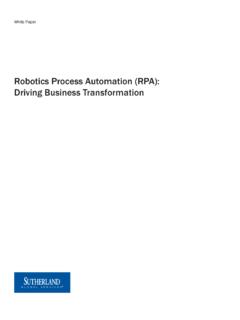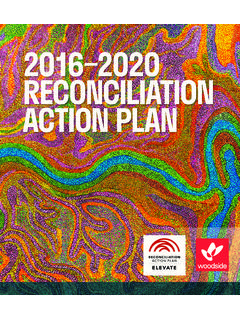Transcription of CRITERIA FOR THE USE AND MANAGEMENT OF …
1 CRITERIA FOR THE USE AND MANAGEMENT OF THE research . development GRANT TO universities (2014/15 2016/17). November 2013. 1. PURPOSE. The purpose of this document is to outline the CRITERIA governing the application for, approval and utilisation of research development grants (RDG) at public higher education institutions. 2. BACKGROUND. South African higher education needs to improve its research capacity and capability, particularly in low research intensive universities . Staff qualifications have been identified as a factor which impacts on the quantity and quality of research output.
2 This analysis can also be extrapolated to include teaching productivity and quality. Developing staff capacity is, therefore, an important aspect of the RDG. The percentage of research staff with doctoral qualifications in the university sector currently stands at 38,6% of the total research staff of 17 451 in 2012 . This falls short of the target of 75% of the National development Plan (NDP). In response to this need, the Department of Higher Education and Training (DHET). revised the research development Grant (RDG) in 2011, to improve the development of research capacity within the university sector.
3 In the past, only universities whose actual weighted totals of research outputs were less than their normative weighted research output totals would receive research development funding. Substantial funds have been allocated over the past few years for research development and these have been used to support a number of research related initiatives. Specifically, research development funds have been used to support activities such as: infrastructure 1. development ; incentives for academics and researchers; journal publication page fees.
4 research equipment; awards for top researchers or postgraduate bursaries and developing centres of excellence etc. Although these activities all support research , they tend to support established researchers rather than emerging academics that still require research development . It is therefore not intended that they should be supported through the RDG. universities should use other sources of funding or appropriate earmarked funds allocated by DHET, for these purposes. The main purpose of the RDG is to encourage universities to enhance their research capacity and improve their research productivity through a focus on developing the research capabilities of academic staff.
5 The aim is to channel these funds towards the development of junior/emerging academic staff to enable them to become qualified and competent researchers through Masters, Doctoral, post-doctoral programmes, as well as other training programmes meant to enhance research capability. The ultimate goal of the RDG is to ensure that the qualifications of all academic staff at universities are improved. It is hoped that through this fund, academic staff will improve their research capabilities, become more competent academics, and begin to improve their research productivity thereby contributing to improved quality of research and research productivity of their institutions.
6 In order to ensure that the RDG have the desired impact within the university sector, the DHET has decided on a three year allocation. Each university will be required to develop a RDG proposal for the utilisation of their RDG over the three year period (2014/15 . 2016/17). This document provides the CRITERIA for the use and MANAGEMENT of RDG funds by universities . 3. RDG ALLOCATIONS. All public Higher Education Institutions are eligible for research development grants . The allocations for each university are contained in the Ministerial Statement on University Funding for 2014/15 to 2016/17.
7 These are the approved allocations against which universities must develop their research development Grant proposals. 2. The Ministerial Statement reflects the funding allocations per university for 2014/15 and 2015/16, based on the shares of development funds indicated in Table 1. The method of distributing research development funds amongst universities has already become less sensitive to institutional manipulation. The previous system in which a university received more state funding when it performs less, will no longer apply in future years.
8 universities have been clustered into three categories to enable the Department to set differential targets and norms. The clustering, takes into account individual institutional missions together with the persistent effects of the legacy of inequality among South African higher education institutions. It is based on analysis of HEMIS data, actual weighted research output1 of individual institutions from previous year, and teaching output data. The three clusters are as follows: Cluster A: are institutions that have consistently produced per capita output of units or above.
9 Cluster B: are institutions that have consistently produced per capita output between and per capita. Cluster C: are institutions that have consistently produced per capita output of units or below per capita. The allocation of research development funds across and within the clusters varies depending on the level of capacity building required. Kindly see annexure A for details regarding appropriate development programs to be prioritised for each cluster. 4. FUNDED RDG PROGRAMMES. As part of its integrated institutional planning, each university should develop a holistic research development Plan/ Strategy.
10 Within this overall plan/ strategy, specific activities or programmes aimed at improving the research capabilities of its staff should be identified in 3 year cycles. universities are encouraged to be innovative when developing proposals and designing collaborative programmes. Specific activities may be funded through the RDG. 1. Weighted research output is calculated on the basis of permanently employed academic staff members versus the set norms for research outputs, which include research Masters and Doctoral graduates, resulting in units.

